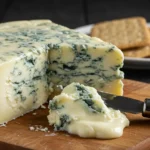Description
Indulge in the creamy, bold flavors of homemade Gorgonzola cheese, a luxurious Italian blue cheese that enhances any dish. This recipe guides you through the traditional process of making Gorgonzola from scratch, ensuring the perfect balance of creamy texture and tangy, complex flavors. Whether crumbled over salads, melted into sauces, or enjoyed on a gourmet cheese board, this rich and flavorful cheese will elevate your culinary creations.
Ingredients
Essential Ingredients
- 4 gallons whole cow’s milk (preferably raw or pasteurized, non-homogenized)
- 1/4 teaspoon Penicillium Roqueforti mold culture (for blue veining)
- 1/4 teaspoon mesophilic starter culture (to acidify the milk)
- 1/2 teaspoon liquid calcium chloride (if using pasteurized milk, to aid curd formation)
- 1/2 teaspoon liquid rennet (diluted in 1/4 cup non-chlorinated water)
- 1 tablespoon cheese salt (for flavor and moisture control)
Optional Enhancements
- 1/8 teaspoon lipase powder (for a sharper, tangier flavor)
- 1 cup heavy cream (for extra richness and a smoother texture)
Instructions
Step 1: Heat the Milk and Add the Starter Culture
- In a large stainless-steel pot, heat 4 gallons of whole milk over low heat until it reaches 86°F (30°C), stirring occasionally.
- Sprinkle mesophilic starter culture over the surface of the milk and let it sit for 2 minutes before stirring gently.
- Cover the pot and let the milk culture for 30 minutes undisturbed.
Step 2: Introduce the Mold and Rennet
- Sprinkle Penicillium Roqueforti mold culture evenly over the milk and let it dissolve for 2 minutes before stirring.
- If using pasteurized milk, add calcium chloride mixed with a small amount of non-chlorinated water.
- Stir in liquid rennet (diluted in water) using an up-and-down motion to distribute evenly.
- Let the milk sit undisturbed for 60 minutes, allowing a firm curd to form.
Step 3: Cut and Drain the Curds
- Once the curd is set, cut it into 1-inch cubes using a long knife in a grid pattern.
- Let the curds rest for 5 minutes, then stir gently every few minutes for 20 minutes while maintaining the 86°F (30°C) temperature.
- Drain about 30% of the whey, ensuring the curds remain moist for proper aging.
Step 4: Molding and Pressing
- Transfer the curds into a cheese mold lined with cheesecloth.
- Lightly press the curds together, ensuring small air pockets remain for blue mold development.
- Flip the cheese every 12 hours over the next 24 hours to help it hold its shape.
Step 5: Salting and Piercing for Blue Veining
- Sprinkle cheese salt over the surface and let it absorb naturally over two days, flipping the cheese daily.
- Move the cheese to an aging space set at 50-55°F (10-13°C) with 85-90% humidity.
- After four days, use a sterilized skewer to pierce multiple holes throughout the cheese to allow oxygen for mold growth.
Step 6: Aging and Final Touches
- Flip the cheese every two days during the first three weeks to ensure even aging.
- Gorgonzola Dolce is ready in two months, while Gorgonzola Piccante develops its intense flavor over three to six months.
- Once aged to your preference, wrap the cheese in wax paper and store it in the refrigerator.
- Let the cheese rest at room temperature for 30 minutes before serving to bring out its full depth of flavor.
Notes
- Milk Quality Matters: For the best flavor, use raw milk. If using pasteurized milk, always add calcium chloride.
- Piercing Technique: Ensure the cheese is pierced thoroughly, as oxygen is essential for blue veining.
- Storage Tip: Wrap Gorgonzola in wax paper, then loosely cover with foil to maintain freshness.
- Prep Time: 2 hours
- Cook Time: 6 months (aging)
- Category: Cheese Making
- Method: Aged, Fermented
- Cuisine: Italian
